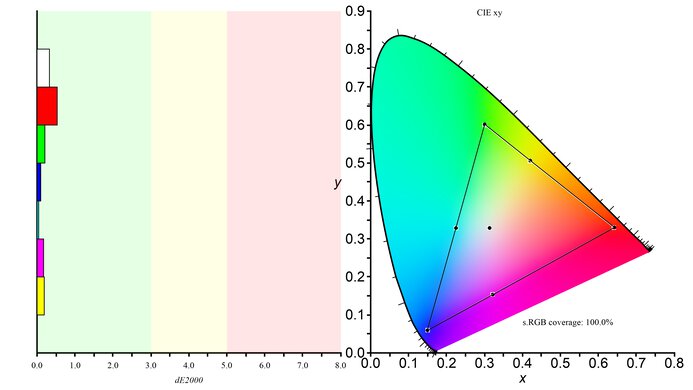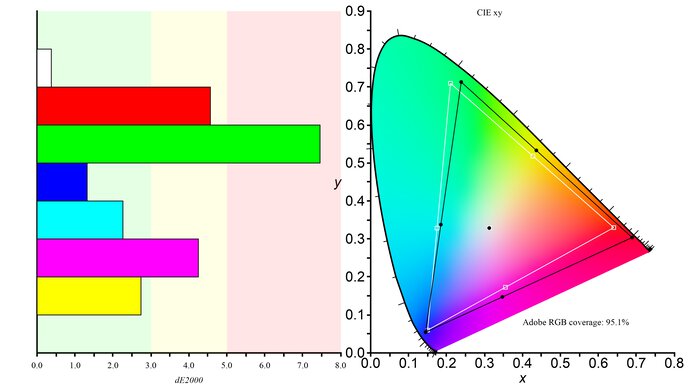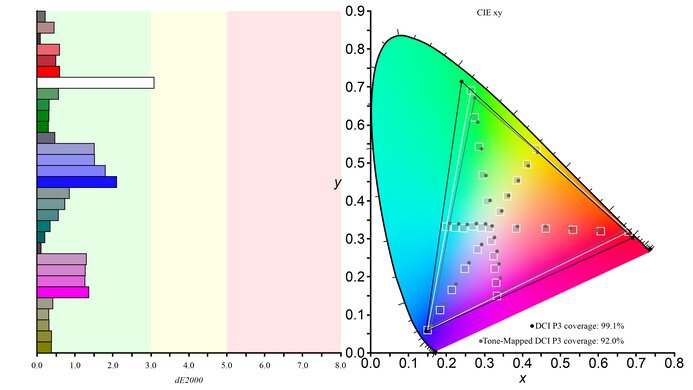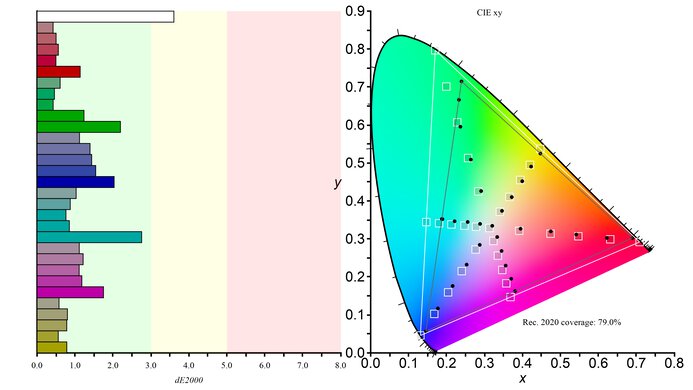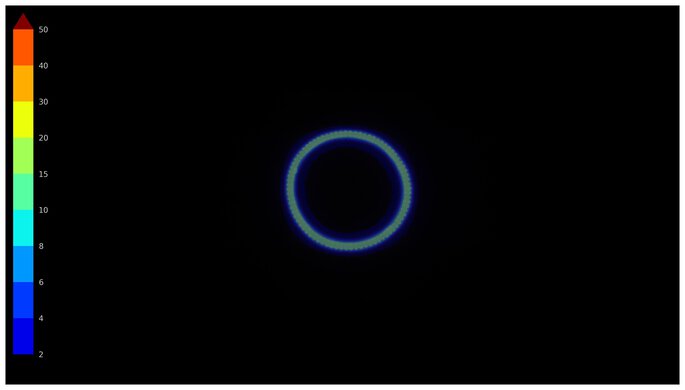The Gigabyte AORUS FO32U2P is a flat 32-inch, 4k gaming monitor with a 240Hz refresh rate. As a part of Gigabyte's premium AORUS gaming brand, alongside the Gigabyte AORUS FO27Q3, it competes with an increasing number of other 32-inch QD-OLED models, such as the Dell Alienware AW3225QF, the ASUS ROG Swift OLED PG32UCDM, and the MSI MPG 321URX QD-OLED. Its stand-out feature is support for DisplayPort 2.1, so the monitor can work at its maximum 240Hz refresh rate without using Display Stream Compression (DSC), provided your graphics card supports this. It also has productivity features such as a USB-C port with up to 65W of power delivery and a KVM switch that makes it easy to multitask with different computers. Lastly, it has features to reduce the risk of OLED burn-in and a three-year warranty against burn-in, although this can change across different countries.
Our Verdict
The Gigabyte AORUS FO32U2P is fantastic for PC gaming. Its near-infinite contrast ratio and perfect black uniformity are ideal for dark room gaming, as blacks look deep and inky. It also gets bright enough for highlights to pop, and colors look rich and vivid. It has a 240Hz refresh rate, so motion looks extremely crisp, and it feels very responsive. Although it supports all common VRR formats, it has some VRR flicker with changing frame rates in darker scenes.
- Near-instantaneous response time.
Displays deep and inky blacks in dark rooms.
- 240Hz refresh rate and VRR support.
- Low input lag.
- Bright and vivid colors.
- Sharp text and image clarity.
- Noticeable VRR flicker with changing frame rates.
- Ambient light causes black levels to rise.
The Gigabyte AORUS FO32U2P is superb for console gaming. It has perfect compatibility with the PS5 and the Xbox Series X|S, as it has HDMI 2.1 bandwidth, and it supports all console features. Its near-instantaneous response time ensures crisp motion, and its input lag is low for a responsive feel. It has exceptional picture quality, with highlights that pop and very vivid colors. It also displays deep blacks in a dark room, so it's great if you're gaming in a darker environment.
- Near-instantaneous response time.
Displays deep and inky blacks in dark rooms.
- Low input lag.
- Bright and vivid colors.
- HDMI 2.1 bandwidth.
- Sharp text and image clarity.
- Ambient light causes black levels to rise.
The Gigabyte AORUS FO32U2P is great for office use, but there are some limitations. Its high-resolution 4k display produces excellent text clarity, and its large screen lets you display multiple windows at the same time. However, while it works well with a few lights around, it doesn't get bright enough to fight strong glare. Additionally, it has the risk of permanent burn-in with constant exposure to the same static elements over time, which is a problem if you're only using it for office work.
- Bright enough to fight glare in most rooms.
Decent reflection handling.
- USB hub and KVM switch.
- Sharp text and image clarity.
- Risk of burn-in.
The Gigabyte AORUS FO32U2P is incredible for photo and video editing. It displays a wide range of vivid colors and is extremely accurate before calibration. Its large 4k screen provides a detailed workspace for editing content, and you can easily have multiple windows open at the same time. It also gets bright enough for small highlights to pop, which is excellent if you're editing in HDR. However, if there's a lot of light shining on the screen, it appears slightly purple, so you'll have more difficulty editing very dark content accurately if this occurs. Also, there is the risk of permanent burn-in with constant exposure to the same static elements over time, like if you always have your editing programs on the screen.
Displays deep and inky blacks in dark rooms.
- Bright and vivid colors.
- Sharp text and image clarity.
- Very accurate sRGB mode.
- Ambient light causes black levels to rise.
- Risk of burn-in.
The Gigabyte AORUS FO32U2P has decent brightness. It's bright enough to fight glare in most well-lit rooms, but not if you have it opposite a sunny window. It also gets bright enough in HDR to make small highlights pop, but larger highlights are dimmer.
- Bright enough to fight glare in most rooms.
- Small highlights pop in HDR.
- Larger highlights are dimmer.
The Gigabyte AORUS FO32U2P has a near-instantaneous response time, resulting in exceptionally sharp motion.
- Near-instantaneous response time.
- Outstanding refresh rate compliance.
The Gigabyte AORUS FO32U2P is outstanding for HDR. Thanks to its near-infinite contrast ratio and perfect black uniformity, it displays deep and inky blacks in dark rooms without any blooming around bright objects. It also displays a wide range of colors and makes them look vivid for a realistic image.
Displays deep and inky blacks in dark rooms.
- Bright and vivid colors.
- Ambient light causes black levels to rise.
The Gigabyte AORUS FO32U2P has outstanding SDR picture quality, displaying deep, inky blacks in dark rooms and a wide range of colors.
Displays deep and inky blacks in dark rooms.
- Bright and vivid colors.
- Ambient light causes black levels to rise.
The Gigabyte AORUS FO32U2P has exceptional color accuracy. It has remarkable accuracy before calibration, so calibration doesn't improve much. It also maintains an accurate image across the screen thanks to its superb gray uniformity.
- Very accurate sRGB mode.
Performance Usages
Changelog
- Updated Nov 10, 2025: We've converted this review to Test Bench 2.1.1. We removed the Vertical Viewing Angle test.
-
Updated Sep 12, 2025:
We added in Additional Features that it has a Pixel Clean feature to run a pixel refresh cycle.
-
Updated Aug 25, 2025:
Updated HDR Brightness to note that, in the previously used 'HDR' picture mode, most parts of scenes are too bright.
-
Updated Aug 04, 2025:
We updated HDR Brightness, as the F06 firmware update adds a new recommended 'HDR Peak 1000' picture setting and changes the performance of the previously recommended 'HDR' setting.
Check Price
Differences Between Sizes And Variants
We tested the 32-inch Gigabyte AORUS FO32U2P, which is the only size available. A variant of this model, the FO32U2, lacks several features of the FO32U2P. You can see these differences below. The results are only valid for this model.
| Model | Size | Resolution | Panel Type | Refresh Rate | DP 2.1 | Mini DP | USB-C Power |
|---|---|---|---|---|---|---|---|
| FO32U2P | 32" | 4k | QD-OLED | 240Hz | Yes | Yes | 65W |
| FO32U2 | 32" | 4k | QD-OLED | 240Hz | No | No | 18W |
Our unit was manufactured in March 2024; you can see the label here. We tested it with firmware F03.
Popular Monitor Comparisons
The Gigabyte AORUS FO32U2P is an outstanding gaming monitor for PC and console gamers, and it is one of the best monitors on the market. Its 4k resolution ensures a detailed image, and its 240Hz display provides a crisp and responsive feel. It displays deep blacks next to bright highlights in a dark room, and small highlights pop. Like the ASUS ROG Swift OLED PG32UCDM, it has several features that enhance productivity, such as a USB-C port and a KVM switch. Its stand-out feature is support for DisplayPort 2.1, so it's future-proof if you want to use the display without Display Stream Compression (DSC). However, it doesn't have Dolby Vision support, so if that's important, you may want to consider another similar monitor like the Dell Alienware AW3225QF, which has Dolby Vision, or the ASUS, which will receive Dolby Vision support in a future update.
Also, see our recommendations for the best OLED monitors, the best gaming monitors, and the best HDR gaming monitors.
The ASUS ROG Swift OLED PG32UCDM and the Gigabyte AORUS FO32U2P are both 32-inch QD-OLED gaming monitors with very similar performance. The ASUS is the better choice if you plan to watch a lot of movies, as it supports Dolby Vision after a firmware update. However, the Gigabyte is a better choice for console gamers, as it has lower input lag at both 60Hz and 120Hz. The Gigabyte is also a better choice if future-proofing is important to you, as it supports DisplayPort 2.1 bandwidth and doesn't require Display Stream Compression to reach its maximum resolution and refresh rate.
The Gigabyte AORUS FO32U2P and the MSI MPG 321URX QD-OLED are 32-inch 4k @ 240Hz QD-OLED monitors. The MSI is better if you have a laptop that draws a lot of power, as it provides up to 90W of power delivery over USB-C. The MSI is also a better option if you're sensitive to VRR flicker. However, the Gigabyte is a better option if you want to use the monitor as a USB hub, as its USB-A ports are much faster.
The Gigabyte AORUS FO32U2P and the MSI MPG 322URX QD-OLED are both 32-inch 4k 240Hz QD-OLED gaming monitors. Both monitors have very similar performance and UHBR20 support, and for most people the better option is whichever one you can find cheaper. However, if you're gaming in a brighter room, the Gigabyte is a better option, as it gets brighter in SDR. However, the MSI is a better option if you're connecting a laptop that draws lots of power, as it delivers much more power over USB-C.
The Gigabyte AORUS FO32U2P and the Dell Alienware AW3225QF are 32-inch QD-OLED gaming monitors that have a very similar performance. If you prefer a curved display or plan to watch a lot of movies, the Dell is the better choice, as it has a 1700R curve, supports Dolby Vision, and has an eARC port for sending audio to a soundbar or receiver. However, if you plan to use your monitor for editing or productivity work, the Gigabyte is a better option. In addition to having a flat panel, it also has a KVM switch, provides 65W of power delivery over USB-C, and supports DisplayPort Alt mode.

We buy and test more than 30 monitors each year, with units that we buy completely on our own, without any cherry-picked units or samples. We put a lot into each unbiased, straight-to-the-point review, and there's a whole process from purchasing to publishing, involving multiple teams and people. We do more than just use the monitor for a week; we use specialized and custom tools to measure various aspects with objective data-based results. We also consider multiple factors before making any recommendations, including the monitor's cost, its performance against the competition, and whether or not it's easy to find.
Test Results

The Gigabyte AORUS FO32U2P is dark gray and has a gamer-oriented design. While looking relatively straightforward from the front, the back has RGB lighting.
The build quality is fantastic. The plastic materials are solid and don't flex or creak easily. However, there's a circular shroud on the stand that's loose, and it rattles if you move it, though it's cosmetic and doesn't impact your use of the monitor. The stand features a metal base and a plastic pillar, and it supports the monitor well, with great recovery if it's bumped. There isn't any noticeable fan noise.
The ergonomics are fantastic. It has excellent height adjustment, so it's easy to place in your preferred position for a long gaming session. It also has a good swivel range, so it's easy to share your screen with someone else. The stand features both a cutout and a clip for cable management.
The V-shaped stand is solid and holds the screen well. The thickness measurement is with the monitor at its minimum height. At its maximum height, it's 7 inches (17.7 cm) thick, as the stand is slightly angled.
The monitor has a near-infinite contrast ratio, as its QD-OLED panel can turn individual pixels on and off. This means it displays deep blacks next to bright highlights in dark rooms. That said, like previous QD-OLED displays, ambient light causes blacks to look purple, so it doesn't display the same deep blacks in bright rooms.
The Gigabyte AORUS FO32U2P doesn't have a backlight, so it doesn't require a local dimming feature. However, with a near-infinite contrast ratio, there isn't any blooming around bright objects, and it's the equivalent of a perfect local dimming feature. We still film these videos on the monitor so you can see how the screen performs and compare it with a monitor that has local dimming.
Settings
- Picture: Custom (after calibration)
- Static Control: Off
- APL Stabilize: High
- Sub-Logo Dim: Off
- Corner Dim: Off
- Brightness: Maximum
The SDR brightness is good. It gets bright enough to fight glare if you set APL Stabilize to 'High,' but it still struggles to fight really intense glare. That said, the trade-off is that there's a difference in brightness between different content, which can be distracting. If that bothers you, it's better to set APL Stabilize to 'Low' as there's more consistent brightness across different content.
The brightness is similar between APL Stabilize on 'Middle' and 'High' for the most part, except 2% windows get much brighter on 'High,' which you can see in the results below. Another thing to note is that with APL Stabilize on 'High', there's an issue with raised black levels. You can change Gamma to '2.4' to fix this issue.
| APL Stabilize | Low | Middle |
|---|---|---|
| Real Scene | 248 cd/m² | 307 cd/m² |
| 2% Window Peak | 252 cd/m² | 454 cd/m² |
| 10% Window Peak | 253 cd/m² | 454 cd/m² |
| 25% Window Peak | 252 cd/m² | 366 cd/m² |
| 50% Window Peak | 254 cd/m² | 310 cd/m² |
| 100% Window Peak | 251 cd/m² | 259 cd/m² |
| 2% Window Sustained | 251 cd/m² | 451 cd/m² |
| 10% Window Sustained | 251 cd/m² | 450 cd/m² |
| 25% Window Sustained | 251 cd/m² | 364 cd/m² |
| 50% Window Sustained | 252 cd/m² | 309 cd/m² |
| 100% Window Sustained | 249 cd/m² | 258 cd/m² |
Settings
- Picture: HDR Peak 1000
- Static Control: Off
- APL Stabilize: Locked
- Sub-Logo Dim: Off
- Corner Dim: Off
The HDR brightness is adequate. It gets bright enough to make really small highlights pop, but it can't sustain this brightness with larger highlights, so they don't stand out as much. It follows the PQ EOTF curve well until there's a gradual roll-off before a sharp cut-off at the peak brightness. This helps to preserve bright details, though highlights don't get as bright as possible.
The 'HDR Peak 1000' Picture mode, which is only available with firmware F06 or newer, has very similar brightness and EOTF tracking to the 'HDR' Picture mode on firmware F05 or earlier. However, after the update to F06, the 'HDR' Picture mode we used previously is less accurate, as most parts of scenes are too bright. Additionally, 'HDR Peak 1000' takes slightly longer to establish a connection to the computer than other modes.
Setting APL Stabilize to 'High' has different effects on the image depending on which Picture mode you choose. APL Stabilize is locked in 'HDR Peak 1000', so you can't adjust it. In 'HDR Game,' dark scenes are over-brightened, which may help you see shadow details in games more easily. However, it's not as accurate as 'HDR Peak 1000', and highlights don't get as bright. 'HDR Movie' has a far more gradual roll-off, so highlights don't get nearly as bright as 'HDR Peak 1000'. However, you may prefer this mode if you're connecting a device that doesn't allow you to configure HDR brightness.
The accuracy before calibration in the 'sRGB' picture mode is remarkable. The white balance and most colors are very accurate, and the color temperature is fairly close to the 6500K target. Gamma follows the target curve fairly well when APL Stabilize is set to 'Low,' though dark scenes are slightly too dark. Using the sRGB mode locks you out of a few settings, including Contrast, and you need to use another mode with worse color accuracy if you want access to those settings.
Note that if you set APL Stabilize to either 'Middle' or 'High,' gamma is quite far off the target curve. You can see this here, where APL Stabilize is set to 'Low' in the left graph, 'Middle' in the middle graph, and 'High' in the right graph. You can see the incorrect brightness levels in various parts of an image when looking at content or the desktop.
The accuracy after calibration is fantastic when APL Stabilize is set to 'Low,' and you won't notice any issues. However, if you set APL Stabilize to 'Middle' or 'High,' gamma doesn't follow the target curve well.
The SDR color gamut is superb. It displays all colors in the common sRGB color space and a wide range of colors in the Adobe RGB color space, which is sometimes used for photo editing. That said, some colors are off in Adobe RGB, and it oversaturates red.
The HDR color gamut is fantastic. It displays nearly all colors in the common DCI-P3 color space and a wide range in the Rec. 2020 color space, and colors are fairly accurate.
The Gigabyte AORUS FO32U2P has an amazing HDR color volume. Thanks to its QD-OLED panel, it displays bright and vivid colors without any issues, and dark colors look fantastic, too.
The horizontal viewing angle is outstanding. Although it technically isn't perfect, you visually won't see any inconsistencies when viewing from the sides or if you sit close to the screen.
The Gigabyte AORUS FO32U2P has excellent text clarity. Thanks to its high pixel density, text looks very sharp, and enabling Windows ClearType (top photo) improves the boldness of letters. These photos are in Windows 10, and you can also see them in Windows 11 with ClearType on and with ClearType off.
Due to the triangular subpixel layout, there's still some color fringing around letters and at the edge of windows, so text doesn't look quite as good as on other 4k monitors with IPS and VA panels. However, it's hard to see unless you look closely at the monitor. Although we didn't experience any eye strain during testing, even with long periods of use, this is something that changes from person to person, and it depends on how sensitive you are to this subpixel layout.
The direct reflection handling is decent. With a glossy coating, it has mirror-like reflections, but they aren't strong.
The black levels rise in a bright room. This is typical of QD-OLEDs as they lack a polarizer, causing blacks to look purple. You need to use it in a dark room to get perfect blacks.
You can reach the max refresh rate with a 4k resolution over both DisplayPort and HDMI. If your graphics card supports DisplayPort 2.1's full bandwidth of 80Gbps, you can do this without Display Stream Compression (DSC). However, if your graphics card only supports DisplayPort 1.4 bandwidth or you're using HDMI, it needs to use DSC to reach the maximum frame rate and resolution. Most modern graphics cards support DSC.
Though you can't turn DSC off, it shouldn't be active, provided your selected resolution and refresh rate don't exceed the bandwidth limitation of your graphics card's connected port. If you're looking for an OLED monitor with a much higher maximum refresh rate, check out the ASUS ROG Swift OLED PG32UCDP, which has a 1080p @ 480Hz mode.
| NVIDIA | VRR Min | VRR Max |
| DisplayPort | <20Hz | 240Hz |
| HDMI | <20Hz | 240Hz |
| AMD | VRR Min | VRR Max |
| DisplayPort | <20Hz | 240Hz |
| HDMI | <20Hz | 240Hz |
On top of FreeSync and G-SYNC compatibility, the Gigabyte AORUS FO32U2P also supports HDMI Forum VRR.
| Refresh Rate | CAD Heatmap | RT Chart | Pursuit Photo |
| 239 | Heatmap | Chart | Photo |
| 165 | Heatmap | Chart | Photo |
| 144 | Heatmap | Chart | Photo |
| 120 | Heatmap | Chart | Photo |
| 100 | Heatmap | Chart | Photo |
| 80 | Heatmap | Chart | Photo |
| 60 | Heatmap | Chart | Photo |
The Gigabyte AORUS FO32U2P has outstanding motion handling across its entire refresh rate range with VRR enabled. CAD remains low throughout, and there's minimal blur with fast-moving objects.
The refresh rate compliance is outstanding. Its near-instantaneous response time means it makes full-color transitions before drawing the next frame.
The Gigabyte AORUS FO32U2P doesn't have an optional black frame insertion feature to reduce the persistence blur further.
The Gigabyte AORUS FO32U2P has noticeable VRR flicker with changing frame rates in the darker parts of scenes. Although it isn't as bad as some other OLEDs, it's still there and can be distracting if the frame rate changes a lot. That said, this doesn't happen if your PC can maintain fairly consistent frame rates.
The Gigabyte AORUS FO32U2P has low input lag for a responsive feel.
Its daisy-chaining port is limited to DisplayPort 1.4 bandwidth.
The DisplayPort Alt Mode on the USB-C port allows you to connect a laptop to display an image from it and charge it with 65W of power at the same time.
- If you turn Type-C Compatibility on, the monitor is limited to 4k @ 60Hz when using a USB-C cable to display the image. This mode increases compatibility with mobile devices.
- If you turn USB 3.2 Support on, the monitor is limited to 4k @ 120Hz when using a USB-C cable to display the image.
| Connection | HDMI 2.0 | HDMI 2.1 | USB-C (M1) | USB-C (M2) |
| Max Refresh Rate | 60Hz | 240Hz | 120Hz | 240Hz |
| VRR Range | N/A | 48-240Hz | 48-120Hz | 48-240Hz |
| HDR | Yes | Yes | Yes | Yes |
The Gigabyte AORUS FO32U2P works well with macOS. If you use a MacBook, windows don't migrate to or from the display when closing the lid or waking the laptop from sleep with USB-C or HDMI 2.1. However, with HDMI 2.0, windows do return to their original position when opening the lid or waking the MacBook up from sleep. The KVM works well with macOS, though daisy chaining doesn't work.
The Gigabyte AORUS FO32U2P has a number of extra features, including:
- KVM switch: Allows you to use the same keyboard and mouse with two different sources.
- Resolution Switch: You can use this setting to change the resolution and size of the display, including decreasing the image size to simulate a 24.5 or 27-inch screen size.
- Game Assist: Includes extra settings, like crosshairs, FPS counter, PC info, and different vision modes.
- Daisy Chaining: Allows you to connect another monitor with only one cable going to your computer.
Like most OLED displays, there are also a few settings to help reduce the risk of burn-in, which you can find in the OLED Care section of the OSD. Gigabyte also offers a three-year warranty, including against burn-in, although that may vary between regions.
- Pixel Clean: Runs a pixel refresh cycle, which you have to start manually.
- Pixel Shift: Moves the image by a few pixels to one side to help reduce the risk of burn-in.
- Corner Dim: Dims the four corners of the screen.
- Sub-Logo Dim: Dims static logos and the taskbar to help prevent image retention.
- Static Control: Automatically dims the screen when there's inactivity.




















